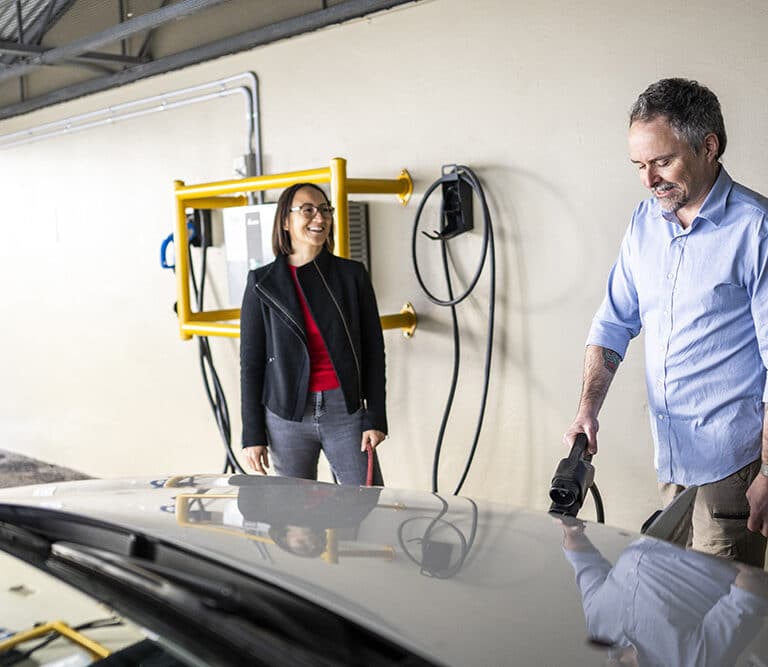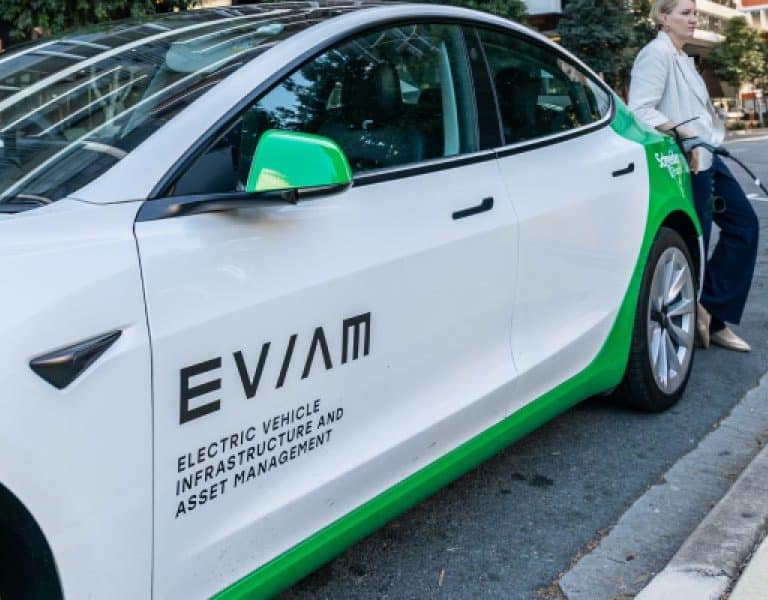The rapid uptake of electric vehicles (EVs) has the power to shift the way Australians view sustainable transportation. However, one of the questions that current EV owners and potential buyers often face is how to charge their vehicles efficiently and conveniently.
Today’s primary charging methods are AC (alternating current) and DC (direct current) charging. Understanding the differences between these two charging options is essential to make informed decisions when it comes to refuelling your EV.
In this article, we will delve into the distinctions between AC and DC charging for electric vehicles, exploring their advantages, disadvantages, and real-world applications.
AC/DC: We’re on the highway…
AC and DC charging are two sides of the same coin when it comes to electric vehicle charging. Each method has its unique advantages and best-use scenarios.
In most cases, AC charging is ideal for daily use, offering convenience and affordability. It’s an ideal option for overnight charging at home or at destinations where you have ample time for your EV to regroup.
DC charging, on the other hand, serves as the solution for rapid charging needs, particularly during long trips. It provides a quick boost to your vehicle’s battery, enabling you to cover longer distances with minimal downtime.
The key to making the most of your EV is understanding when and where to use AC and DC charging. In an increasingly electrified future, a combination of both technologies may be needed to cater to the diverse charging needs of electric vehicle owners. Let’s examine this topic in greater detail.
AC Charging: The steady power source
AC charging is the most common form of EV charging, with 7.4 -22kW power output models being the most typical residential options. Level 2 charging stations are also commonly found in public spaces, such as parking lots, shopping centres, and workplaces.
- Charging speed: AC charging is generally slower compared to DC charging. Level 1 chargers provide the slowest rate, while Level 2 chargers are significantly faster, delivering around 20 to 100 kilometres of range per hour of charging, depending on the EV’s specifications.
- Compatibility: AC charging is universally compatible with all electric vehicles, as these intelligent cars have onboard chargers that can convert AC power to DC power, in order to charge the battery.
- Cost: The cost of installing an AC charging station at home or a commercial location is usually lower than that of a DC fast charger. Level 1 chargers require less planning, while Level 2 chargers require professional installation.
- Steady and safe: AC charging is considered safe and reliable. The power delivery is constant and less likely to damage the battery due to excessive heat or rapid charging. This makes AC charging an ideal choice for overnight power-ups at a residence.
DC Charging: The fast lane
DC charging, often referred to as ‘fast charging’, is typically available at public charging stations. These stations provide high-voltage DC power directly to the vehicle, bypassing the need for an onboard AC charger.
- Charging Speed: DC charging is considerably faster than AC charging. Depending on the charger’s capacity and the EV’s capability, it can add up to 150 kilometres of range in just 30 minutes or less.
- Compatibility: While DC fast charging is widely available and compatible with most modern electric vehicles, some older EV models might not support fast charging. Compatibility should be checked before you use a DC fast charger.
- Cost: DC fast charging stations require a higher investment to install and operate, when compared to AC chargers. The high-power infrastructure and cooling systems necessary for fast charging contribute to additional costs.
- Fast and effective: DC charging is best suited for long-distance travel, where quick top-ups are necessary to continue the journey. This option is also valuable in urban areas where fast charging can minimise wait times for EV drivers.
When to embrace AC charging
Electric vehicle owners often grapple with the decision between AC and DC charging. In many settings, AC charging proves advantageous due to its compatibility and specific benefits.
As mentioned above, most EV owners prefer the idea of charging their car at home, using Level 1 or Level 2 AC chargers. Overnight AC charging ensures a steady, full battery while the vehicle rests. By the time you wake up, your EV is ready to tackle the daily commute.
Workplaces have similarly embraced AC charging, with some providing Level 2 stations for employees. This offers a gradual yet useful charge-up during work hours. Increasingly, you will find AC chargers at destinations such as hotels and shopping centres – where visitors can top up their EVs progressively.
In regions with limited electrical infrastructure or grid constraints, AC charging often becomes the sole practical choice, delivering reliable charging. It also eases the burden on electrical grids, reducing voltage fluctuations.
AC charging can also extend the overall life of your EV battery. In short – this type of charge is universally compatible, cost-effective, and suitable for multiple scenarios.
When to embrace DC charging
DC charging (often referred to as DC fast charging) plays a pivotal role in scenarios where the need for quick and efficient recharging takes priority.
DC fast charging is particularly useful for long-distance car travel. EV drivers embarking on extended journeys rely on DC fast charging to rapidly add substantial range to their batteries. For example, if an EV driver must leave an area quickly and needs a quick recharge to reach the nearest safe location, DC fast charging can even be a lifesaver.
When rapid refuelling is imperative, DC charging is again the top choice. For vehicles that operate continuously – such as taxis, delivery vehicles, rental cars, or electric buses – minimising downtime is crucial. DC fast charging ensures that these vehicles spend more time on the road and less time at charging stations, making it the go-to option for fleets in constant motion.
For anyone operating a commercial fleet, the ability to recharge EVs quickly and get drivers back on the road offers a significant advantage. Businesses with multiple EVs requiring simultaneous charging, such as a rental car parking lot, can benefit from DC fast charging stations that efficiently serve multiple vehicles.
Furthermore, in areas with fluctuating electricity costs and peak-hour pricing, DC fast charging can help mitigate the impact of expensive electricity rates by reducing the time needed for recharging.
Information for property developers
More and more, Australia’s property developers should consider including EV charging units in their projects, for several compelling reasons:
- Future-proofing properties: As the global shift toward sustainable transportation accelerates, demand for EVs is on the rise. By installing EV charging units in their developments, property developers can attract environmentally conscious tenants or buyers and future-proof their properties for the growing EV market.
- Enhanced property value: Properties with EV charging infrastructure may be perceived as more valuable by potential buyers or renters. This feature can be a significant selling point and potentially lead to higher property sale prices.
- Market competitiveness: Including EV charging infrastructure can set a development apart from competitors. With more consumers choosing electric vehicles, properties with charging stations can be more attractive and competitive in the real estate market.
- Increased tenant or resident satisfaction: EV owners are more likely to choose a property with convenient charging access. Offering this service can lead to higher tenant or resident satisfaction, potentially reducing turnover rates and vacancy periods.
- Green building credentials: Installing EV charging units aligns with sustainability goals and can contribute to green building certifications, enhancing a given property’s eco-friendly status.
- Regulatory compliance: In some states, local building regulations now require the inclusion of EV charging infrastructure in new developments. Being proactive in meeting these requirements can save time and resources in the long run.
- Attracting commercial tenants: For multipurpose properties incorporating office buildings or shopping centres into development plans, offering EV charging can attract businesses that prioritise sustainability and offer EV charging as a perk for employees or customers.
- Charging revenue: Property developers can generate additional revenue by offering paid EV charging services. EV owners are willing to pay for the convenience of charging at their residence or place of work, creating another potential income stream.
- Sustainability: Including EV charging units supports environmental sustainability by encouraging the use of clean energy for transportation. This contributes to a reduction in the property’s overall carbon footprint.
To sum up, incorporating EV charging units into new property developments is a strategic move that aligns with both market trends and environmental needs.
Information for commercial or fleet operators
Businesses operating a commercial fleet should consider including EV chargers for several compelling reasons:
- Meeting market demand: As the popularity of electric vehicles continues to grow, there is a rising demand for EV infrastructure. By offering EVs with charging infrastructure, rental car companies can cater to a broader customer base and stay competitive in the market.
- Attracting eco-conscious customers: EVs are increasingly preferred by environmentally conscious consumers. Offering EVs with charging units allows rental companies to attract customers who want to reduce their carbon footprint while on the road.
- Diversifying the Fleet: Adding EVs to the rental fleet diversifies the vehicle options available to customers. This can be especially appealing to travellers who are interested in experiencing electric mobility.
- Cost savings: EVs generally have lower operating costs compared to traditional internal combustion engine vehicles. Rental car companies can benefit from reduced fuel and maintenance expenses – potentially increasing profitability in the long run.
- Corporate rentals: Many companies are adopting electric vehicles for their corporate fleets due to environmental and cost-saving advantages. Rental car companies can attract corporate clients by offering EVs with charging options for business travel.
- Marketing and branding: Renting electric vehicles can be a strong marketing point for rental car companies, demonstrating a commitment to sustainability and innovation. This can enhance the company’s brand image and appeal to a broader audience.
- Government incentives: In some states, there may be government incentives and tax benefits available for rental car companies that include electric vehicles in their fleets. This may offset the initial investment cost.
- Charging service revenue: Rental car companies can generate additional revenue by offering charging services. They can charge customers for the electricity used during the rental period, creating a new income stream.
Australia’s transport sector is shifting towards electric mobility. Rental car companies that embrace this trend and invest in EV charging infrastructure will be better positioned for the future, and remain more competitive.
The EVIAM approach
If you’re ready to embrace the future of EV technology, the team at EVIAM can help. Whether you need AC charging or DC charging or a combination of both, we can offer a comprehensive, full-service approach that addresses the entire lifecycle of your charging infrastructure. Our experts will begin by assessing your present and future requirements, and from there we can design and deliver a customised, scalable solution for your long-term needs. And with EVIAM, you will always own your infrastructure outright.
Unlike providers who may be tempted to ‘set and forget’, we recognise that EV charging is an ever-evolving field. With EVIAM in your corner, you can prepare to make the most of Australia’s changing transport landscape, while gaining a competitive edge, recovering costs or even boosting your revenue, and contributing towards a more sustainable future.


